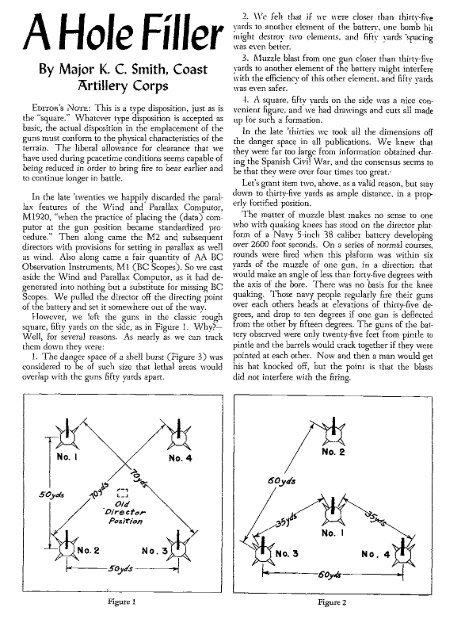January-February - Air Defense Artillery
January-February - Air Defense Artillery
January-February - Air Defense Artillery
Create successful ePaper yourself
Turn your PDF publications into a flip-book with our unique Google optimized e-Paper software.
A Hole Filler<br />
By Major K. C. Smith, Coast<br />
<strong>Artillery</strong> Corps<br />
EDITOR'S NOTE: This is a type disposition, just as is<br />
the "square." Whatever type disposition is accepted as<br />
basic, the actual disposition in the emplacement of the<br />
guns must conform to the physical characteristics of the<br />
terrain. The liberal allowance for clearance that we<br />
have used during peacetime conditions seems capable of<br />
being reduced in order to bring fire to bear earlier and<br />
to continue longer in battle.<br />
In the late 't~'enties we happily discarded the parallax<br />
features of the vVind and Parallax Computor,<br />
MI920, "v\!henthe practice of placing the (data) computor<br />
at the gun position became standardized procedure."<br />
Then along came the M2 and subsequent<br />
directors with provisions for setting in parallax as \vell<br />
as wind. Also along came a fair quantity of AA BC<br />
Observation Instruments, Ml (BC Scopes). So we cast<br />
aside the 'Wind and Parallax Computor, as it had degenerated<br />
into nothing but a substitute for missing BC<br />
S~opes. We pulled the director off the directing point<br />
of the battery and set it somewhere out of the wav.<br />
However: we left the guns in the classic 'rough<br />
square, fifty yards on the side, as in Figure 1. Why?-<br />
Well, for several reasons. As nearly as we can t;ack<br />
them down they \vere: '<br />
1. The dang~r space of a shell burst (Figure 3) was<br />
considered to be of such size that lethal areas would<br />
overlap with the guns fifty yards apart.<br />
~ ~<br />
1 No.4<br />
THO.<br />
SOyd$<br />
~O.2<br />
I~<br />
~()i<br />
~':1<br />
,.-,<br />
L_J<br />
0/(/<br />
'Dlrecfcl""<br />
Positicn<br />
50Y'ls-~<br />
NO.3~<br />
2. \ Ve felt that if ,,'e "'ere closer than thirty-five<br />
yards to another element of the battery, one bo~b hit<br />
might destroy two elements. and fift~, yards 'spacing<br />
was eyen better.<br />
3. l\1uzzle blast from one gun closer than thirtv-five<br />
yards to another element of the battery might int~rfere<br />
with the efficiencyof this other element, and fiftv yards<br />
was even safer. ..<br />
4. A square, fifty yards on the side was a nice convenient<br />
figure, and we had drawings and cuts all made<br />
up for such a formation.<br />
In the late 'thirties we took all the dimensions off<br />
the danger space in all publications. We kne~' that<br />
they were far too large from information obtained during<br />
the Spanish Civil War, and the consensus seems to<br />
be that they were over four times too great.'<br />
Let's grant item t\\'O,above, as a valid reason, but stay<br />
dow~ to thirty-five yards as ample distance, in a properly<br />
fortified position.<br />
The matter of muzzle blast makes no sense to one<br />
:vho wi~h quaking knees has stood on the director platform<br />
of a Navy 5-inch 38 caliber battery developing<br />
over 2600 foot seconds. On a series of normal courses,<br />
rounds were fired when this plaform was within six<br />
yards of the muzzle of one gun, in a direction that<br />
would make an angle of less than forty-fivedegrees with<br />
the axis of the bore. There was no basis for the knee<br />
quaking. Those navy people regularly fire their guns<br />
over each others heads at elevations of thirty-five degrees,<br />
and drop to ten degrees if one gun is' deflected<br />
from the other by fifteen degrees. The guns of the battery<br />
observed were only twenty-five feet from pintle to<br />
pintle and the b-arrelswould crack together if they were<br />
pointed at each other. Now and then a man would get<br />
his hat knocked off, but the point is that the blasts<br />
did not interfere \vith the firing.<br />
Figure 1 Figure 2
















